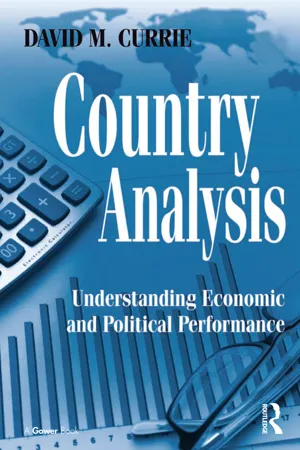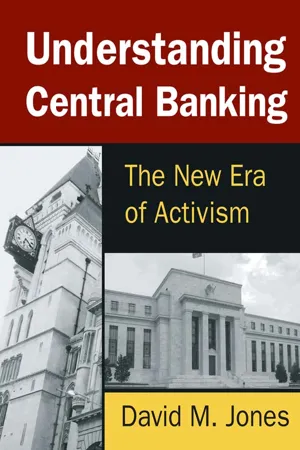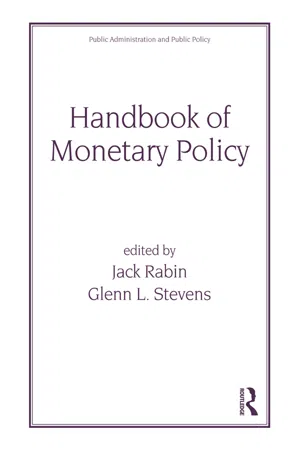Conventional Monetary Policy Tools
Conventional monetary policy tools refer to the standard measures used by central banks to influence the money supply and interest rates. These tools typically include open market operations, discount rate changes, and reserve requirements. By adjusting these tools, central banks aim to achieve their macroeconomic objectives, such as price stability and full employment.
5 Key excerpts on "Conventional Monetary Policy Tools"
- eBook - ePub
- Anthony J. Makin(Author)
- 2016(Publication Date)
- Routledge(Publisher)
...C H A P T E R 8 The central bank and monetary policy This chapter focuses on the role of money and the central bank in open economies. Central banks implement monetary policy by controlling the money supply to influence domestic interest rates and exchange rates and have considerable discretionary powers to conduct monetary policy independent of national governments. The increased independence of central banks arose from concerns that direct government manipulation of the money supply for political reasons led to higher inflation. Owing to financial deregulation and globalisation, the conduct of monetary policy has changed markedly over recent decades. In particular, there has been a worldwide shift away from credit rationing approaches, previously implemented via techniques to alter the quantity of funds that domestic commercial banks could lend, to more market-oriented approaches. In the past, debate about monetary policy has centred on the relative importance of its end goals – low inflation and low unemployment – and on the best means of achieving those goals. Central banks worldwide currently see inflation control as the main objective of monetary policy. In the short term, monetary policy affects real economic activity and hence employment via short-term interest rates and nominal exchange rates. In the long term, however, monetary policy only affects the domestic price level, and hence inflation and the exchange rate. In what follows, we examine the monetary system, inflation and the operation of monetary policy in the short and long run. The central bank and the monetary system Figure 8.1 depicts the typical structure of an economy’s financial and monetary system. This system is essentially a network of financial institutions, which, by and large, act as intermediaries, or go-betweens, for savers and investors in the economy...
- eBook - ePub
Country Analysis
Understanding Economic and Political Performance
- David M. Currie(Author)
- 2016(Publication Date)
- Routledge(Publisher)
...The Fed buys and sells securities daily or weekly, for example, while the reserve requirement changes perhaps once in a decade under ordinary circumstances. The tools also have different degrees of effectiveness. For example, changing the reserve requirement only slightly leads to dramatic changes in bank lending and consequently in the performance of the economy. All these tools have the effect of influencing credit conditions by raising or lowering interest rates throughout the economy. Credit conditions are the ability or tendency to lend or borrow, a practice we have turned into a national obsession in the US. The same tools are available in other countries, although they frequently have different names. The three tools can be used to implement monetary policy, the desire of the central bank to influence economic conditions such as unemployment, inflation, or the foreign exchange value of the nation’s currency. When people don’t have jobs or businesses are not selling as much as they wish, the central bank may pursue an easy money policy by making more money available through the banking system. When the rate of inflation is high, the central bank may pursue a tight money policy by making money more difficult to obtain. Using the three tools to influence the right amount of money in an economy is a delicate task. This is the central bankers’ dilemma : striking the balance between too much money, which causes inflation, and too little money, which causes recession. Box 6.3 describes how three central banks viewed the dilemma in mid-2007. Box 6.4 explains the dilemma facing the Fed shortly after a new chairman was appointed. Box 6.3 Different economic conditions, different bank policies Central bank policies depend on economic and financial conditions in the home country. This became evident about the time of the Northern Rock crisis described in Box 6.2...
- eBook - ePub
Understanding Central Banking
The New Era of Activism
- David M Jones(Author)
- 2014(Publication Date)
- Routledge(Publisher)
...dollar. At its core, U.S. monetary policy means setting the official interest rate (the federal funds rate target) at which the central bank deals with the banking system. (Federal funds are bank reserve balances held at the Fed that are loaned and borrowed among banks, usually overnight). When Fed authorities ease their policy stance, for example, they seek to exert downward pressure on interest rate levels and try to narrow risk spreads while putting upward pressure on prices of stock, houses, and other financial assets. Also in response to Fed easing, one would expect to see downward pressure on the value of the U.S. dollar in the foreign exchange markets. The result is expected to boost aggregate demand, output, employment, and eventually inflation. R EACTION TO F INANCIAL C RISES To be effective in the modern era of massive global capital flows—those typically triggered by risk-taking portfolio managers in search of maximum returns world-wide—central banks must react to financial crises or panics, as well as to cyclical excesses, promptly and aggressively. The central bank must, first and foremost, do everything possible to maintain its anti-inflation credibility, and especially to keep the public’s longer-term inflation expectations low and well anchored. It must also demonstrate a fervent desire and willingness to act imaginatively, promptly, and on a sufficiently massive scale to deal with the problem at hand, as in the Great Credit Crisis of 2007–2009...
- eBook - ePub
- Jack Rabin, Jack Rabin(Authors)
- 2020(Publication Date)
- Routledge(Publisher)
...24A Primer on Monetary PolicyPart II: Targets and IndicatorsCarl E. WalshProfessor of Economics, University of California, Santa Cruz, CaliforniaReprinted from:FRBSF Economic Letter, No. 94–28 (Aug. 19, 1994).CHANNELS OF MONETARY POLICYEconomists disagree about the exact linkages among monetary policy actions, inflation, and economic activity. Most agree that banks play a critical role in the transmission process, although evidence is inconclusive about whether it is through the liability side of banks’ balance sheets (deposits and other components of the money supply) or through the asset side (bank loans). In either case, the general view is that monetary policy works by affecting interest rates. Increases in interest rates raise the cost of borrowing and lead to reductions in business investment spending and household purchases of durable goods such as autos and new homes. These declines in spending reduce the aggregate demand for the economy’s output, leading firms to cut back on production and employment. Conversely, interest rate declines stimulate aggregate spending and lead to increases in production and employment.Since the Fed can control thefederal funds rate, it would appear to be a simple matter to link policy actions—changes in the funds rate—to real economic activity. Unfortunately, four critical problems arise in implementing monetary policy. First, while the Fed can affect market interest rates, spending decisions and economic activity depend onrealinterest rates, that is, market rates corrected for expected rates of inflation. Second, economic activity is likely to be related to both short-term and long-term real interest rates, while the Fed most directly controls very short-term market rates. Third, the Fed is interested ultimately in measures of economic performance like inflation, real economic growth and employment, yet data on these variables that might be used to guide policy are not available every day or every week or even every month...
- eBook - ePub
- Milton Friedman(Author)
- 2017(Publication Date)
- Routledge(Publisher)
...Such a policy would submit each country to the vagaries not of an impersonal and automatic gold standard but of the policies—deliberate or accidental—of other monetary authorities. In today’s world, if monetary policy is to provide a stable background for the economy it must do so by deliberately employing its powers to that end. I shall come later to how it can do so. Finally, monetary policy can contribute to offsetting major disturbances in the economic system arising from other sources. If there is an independent secular exhilaration-—as the postwar expansion was described by the proponents of secular stagnation—monetary policy can in principle help to hold it in check by a slower rate of monetary growth than would otherwise be desirable. If, as now, an explosive federal budget threatens unprecedented deficits, monetary policy can hold any inflationary dangers in check by a slower rate of monetary growth than would otherwise be desirable. This will temporarily mean higher interest rates than would otherwise prevail—to enable the government to borrow the sums needed to finance the deficit—but by preventing the speeding up of inflation, it may well mean both lower prices and lower nominal interest rates for the long pull. If the end of a substantial war offers the country an opportunity to shift resources from wartime to peacetime production, monetary policy can ease the transition by a higher rate of monetary growth than would otherwise be desirable—though experience is not very encouraging that it can do so without going too far. I have put this point last, and stated it in qualified terms—as referring to major disturbances—because I believe that the potentiality of monetary policy in offsetting other forces making for instability is far more limited than is commonly believed...




